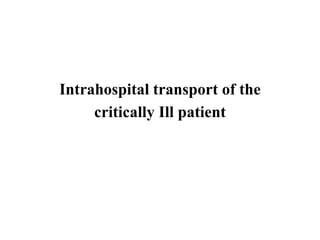16. Intrahospital transport of critically ill patients.pptx
•Download as PPTX, PDF•
0 likes•59 views
نقل المرضى داخل المستشفى
Report
Share
Report
Share

Recommended
critical care nursing 3. critical care criteria for admission & role of nurse

3. critical care criteria for admission & role of nurseBP KOIRALA INSTITUTE OF HELATH SCIENCS,, NEPAL
Recommended
critical care nursing 3. critical care criteria for admission & role of nurse

3. critical care criteria for admission & role of nurseBP KOIRALA INSTITUTE OF HELATH SCIENCS,, NEPAL
More Related Content
What's hot
What's hot (20)
Safe transfer of unstable patient from hospital NABH ppt.pptx

Safe transfer of unstable patient from hospital NABH ppt.pptx
principles of preoperative evaluation and preparation.pptx

principles of preoperative evaluation and preparation.pptx
Multipara monitor – what is it and how does it help

Multipara monitor – what is it and how does it help
Ventilator breathing circuits and its sterilization

Ventilator breathing circuits and its sterilization
Similar to 16. Intrahospital transport of critically ill patients.pptx
Similar to 16. Intrahospital transport of critically ill patients.pptx (20)
Blood Transfusion, Blood Products, and Safety.pptx

Blood Transfusion, Blood Products, and Safety.pptx
Safe transfer of unstable patient from hospital NABH ppt.pptx

Safe transfer of unstable patient from hospital NABH ppt.pptx
Recently uploaded
Recently uploaded (20)
Seal of Good Local Governance (SGLG) 2024Final.pptx

Seal of Good Local Governance (SGLG) 2024Final.pptx
Beyond the EU: DORA and NIS 2 Directive's Global Impact

Beyond the EU: DORA and NIS 2 Directive's Global Impact
SECOND SEMESTER TOPIC COVERAGE SY 2023-2024 Trends, Networks, and Critical Th...

SECOND SEMESTER TOPIC COVERAGE SY 2023-2024 Trends, Networks, and Critical Th...
Presentation by Andreas Schleicher Tackling the School Absenteeism Crisis 30 ...

Presentation by Andreas Schleicher Tackling the School Absenteeism Crisis 30 ...
Web & Social Media Analytics Previous Year Question Paper.pdf

Web & Social Media Analytics Previous Year Question Paper.pdf
Basic Civil Engineering first year Notes- Chapter 4 Building.pptx

Basic Civil Engineering first year Notes- Chapter 4 Building.pptx
Ecological Succession. ( ECOSYSTEM, B. Pharmacy, 1st Year, Sem-II, Environmen...

Ecological Succession. ( ECOSYSTEM, B. Pharmacy, 1st Year, Sem-II, Environmen...
This PowerPoint helps students to consider the concept of infinity.

This PowerPoint helps students to consider the concept of infinity.
ICT Role in 21st Century Education & its Challenges.pptx

ICT Role in 21st Century Education & its Challenges.pptx
16. Intrahospital transport of critically ill patients.pptx
- 1. Intrahospital transport of the critically Ill patient
- 2. Objectives ● Describe major risk factors and common problems associated with transport of critically ill patients. ● Explain the safe organized transport of critically ill patients using the “5 W’s”. ● List the most important equipment required for safe transport. ● Describe proper monitoring of patients for safe transport.
- 3. Introduction Preventing common complications and maintaining physiologic stability is a challenge even in the controlled environment of the ICU. Safe transport requires thoughtful planning, organization, and interdisciplinary communication and cooperation. The goal during transport is to maintain the same level of care, regardless of the location in the hospital.
- 4. Assessment of Risk for Complications Complications may arise from physiologic changes, environmental conditions outside the ICU that are difficult to control or inadvertent movement of equipment. • 76% risk of complications in critically ill patients • 84% of heart patients develop arrhythmias • 46% of problems related to equipment • 25.8% of problems related to lines. (Source: Critical Care Nurse, 2010, Health Science Journal volume (8) 2014)
- 5. Major Risk Factors High ventilator support Many tubes and lines Hemodynamic instability
- 6. Common Problems 1. Related to equipment: • Monitor power failure • Ventilator disconnection • Depleted oxygen supply • Tubes getting kinked 2. Related to patient condition: • Aspiration • Arrhythmias • Hypothermia • Pain
- 7. Common Problems 3. Related to staff: • Gaps in monitoring • Over-ventilation • Under-ventilation • Inadequate knowledge in interpretation and operation of equipment The most common problems were cardiac arrhythmias and equipment problems.
- 8. Safe Organized Transport Remember the 5 W’s Why: Necessary, evaluating risk/ benefits, alternative Who: Patient, staff What: Equipment, ongoing interventions, facilities in the destination When: Time of procedure Where: Best route, special safety requirement
- 9. Recommended Equipment Airway: • oral/nasal airways • soft wrist restraints and sedation • Intubation tray Breathing • Pulse oximeter • Oxygen delivery devices and bag-mask ventilator with positive end expiratory pressure (PEEP) valve • Full oxygen tank with adequate length tubing
- 10. Recommended Equipment Circulation : • Cardiac monitor with defibrillator The most important equipment is: A- Airways B - Breathing: oxygen and saturation monitor C- Cardiac monitor with defibrillator
- 11. Monitoring During Transport Continuously monitored Oxygen saturation ECG monitoring Intermittent monitored Blood pressure Breath sounds
- 12. Key Points Major risk factors during intra-hospital transport are high ventilator support, numerous tubes/lines and hemodynamic instability. The most common problems encountered during intra-hospital transport are arrhythmias and equipment problems. Five W’s: When, Why, What ,Who, and Where.
- 13. Continued Remember important equipment to take during transport: A- airways, B- oxygen and saturation monitors, C- cardiac monitor Continuous oxygen saturation and ECG/cardiac monitoring is mandatory for all ICU patient transports.
- 14. Questions The most common problems encountered during intra-hospital transport of critically ill patients are ______ and _______ . The three major risk factors are____ , ____ and ____. The 5W’s stand for: What are the most important equipment required for safe intra-hospital transport? ______ and ______ are mandatory to monitor during intra-hospital transport.